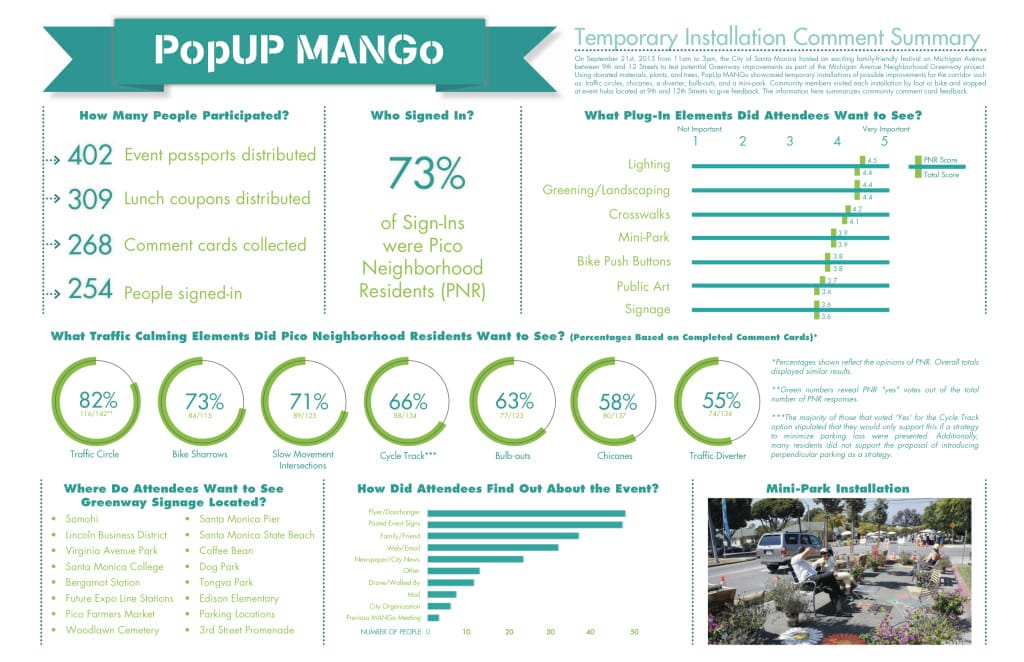MANGo Draft Improvements, 1/7/2013
City planners presented and solicited feedback about their latest plan for the Michigan Avenue Neighborhood Greenway (MANGo) at the final community meeting about the project last night. The plan will be published and sent to the city council by the end of the month in advance of the council’s scheduled vote on the project February 11. If the council votes to adopt the plan, the city would then decide whether to fund through possible grants or city general fund money.
Approximately 70 people, a mix of current and former city employees, local activists, cyclists, and concerned students and citizens attended the meeting, held at Virginia Avenue Park. The project, which runs along Michigan Ave. from Santa Monica High School to a “wiggle” at 18th Street is slated to include Virginia Ave., bordering the park to the north and the nearby Edison Language Academy Elementary School. There are also extensions that would connect the new Expo Line Bergamot Station on the north side and the beach on the west side.
The city transportation planner in charge of the project, Jason Kligier, along with urban designer Amber Hawkes from the consulting firm Meléndrez Design Partners, presented the new “preferred concept” for MANGo before asking attendees to provide their comments with sticky notes on maps around the room.
In addition to feedback received last night, planners will still be accepting community comments until the plan is published. Feedback can be sent to Kligier directly at jason.kligier@smgov.net.
“People can send me comments at any point,” Kligier said. “The plan has already taken shape as the result of a lot of community outreach and no fewer than four community meetings. The plan will be published by the end of the month, and at that point people can send any comments about the published version of the plan to me and they will be directed to the city council.”

Despite past disagreements between community members about potential traffic diversion along the route, the new concept for the route calls instead for turning restrictions at high-traffic volume intersections at Lincoln Avenue and 11th Street. This is also the segment of the project with the highest traffic volumes in general, 4,250 cars per day.
“When we studied the intersections, we noticed that the problems were localized to morning and evening peak pick up and drop off times for the high school,” Kligier said.
The plan now proposes restricting turning movements—no right on red during peak times from Lincoln northbound and southbound onto Michigan (which would eliminate cars whipping around the turns endangering pedestrians in the improved crosswalks). As for 11th St., the city hasn’t finalized its proposed turning restrictions, but is considering restricting turns off of 11th onto Michigan and through movement on Michigan west of 11th during weekdays at peak times.
Once the project is in place the city would monitor the traffic volumes and consider traffic diverters if the volumes are not down to a yet-to-be-determined target volume in line with the goal for the project: to make Michigan Ave. and adjoining sections “a safe and comfortable place for neighbors of all ages to walk, bike, recreate, and interact with one another.”
Most meeting attendees were receptive to some of the design changes planned for the route (including better pedestrian street lighting, landscaped traffic circles, enhanced greenery near the freeway), but some expressed concern in particular with the section of the route nearest Samohi. This portion of the plan around Samohi is part of a separate funding stream through Safe Routes to School, which seeks to provide students with safer opportunities to walk and bike to school.
This project, which is associated with and connected to MANGo, would make 7th Street one way traveling south between Michigan and Pico Boulevard. and add bike lanes traveling in both directions. 7th St. is a popular pick-up and drop-off point for parents of Samohi students.
Planner for this project Michelle Glickert said “the majority of cars go south” on 7th (the counts have shown definitely more than 50 percent). She said the change could increase capacity on the street slightly through a “better-working street” that would also be safer for student walkers and cyclists.
Parents expressed concerns about students walking or biking with heavy instruments and sport bags. They want to be able to easily pick up and drop off students in family cars, but are unsure how the changes on Michigan and 7th will affect their ability to do so. Some parents said students could ride the Santa Monica Big Blue Bus to school more but are unhappy that the student fare is not heavily discounted.
Others cited the lack of a completed traffic impact study as the reason they are not supporting the project—such a study may show where traffic would go given the proposed changes. Glickert said she is currently working on the traffic study and it should be completed in two weeks, before the final proposal is completed.
(Note: This is our first piece by Lindsey Miller. If you’re not familiar with her, visit the “Welcome to the New Santa Monica Next” post from yesterday. – DN)
